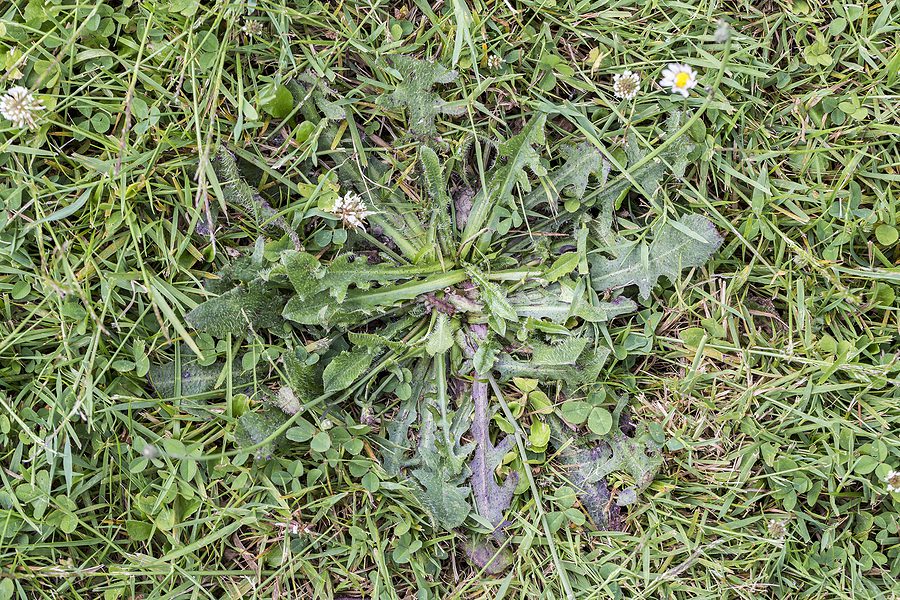How Do I Restore My Lawn That’s Completely Full of Weeds?

Weeds can be a persistent problem when they invade your lawn.
But not to worry, there’s a plan you can follow to put an end to your weed nightmare. Keep reading to find out how to get rid of your weed catastrophe.
Identify the Weeds
To come up with a winning game plan, you’ll need to know exactly what type of weeds you’re up against. Weed treatments are formulated to target certain types of plant species, which means what will kill broadleaf weeds, for example, may leave grass-like weeds unharmed.
To start, give the weeds a once-over, visually, and see which of the following broad categories they belong in.
Select a Proper Herbicide
Next, you’ll need to choose the right type of weed treatment for your type of weed and the point in its life cycle that it has been identified. Pre-emergent herbicides, for example, kill weeds before their seeds ever have a chance to sprout. If your lawn is already infested with weeds, seek a post-emergent herbicide.
You should also make a decision about how much of your lawn is worth saving now. If your yard really is all weeds and dead patches, you might consider a non-selective, broad-spectrum herbicide that will kill everything.
This is a drastic measure, but if the weeds have taken over and you’re just done with grass altogether (or you’d rather start over with a different species of turf grass), you should be able to start from scratch.
Apply the Treatment
On this step, it is especially important that you follow the directions on the herbicide package strictly.
You just need to use the right product at the right time on the weeds. If you don’t, you might end up killing plants you didn’t mean to get rid of, or some local wildlife. Oh, and it might be a good idea to take a peek at the forecast beforehand you wouldn’t want any rainstorm to wash away the herbicide.
Wait It Out
When you can plant seed depends on what kind of weed treatment you use. You should wait for the weeds and their root systems to fully die before continuing. Also, pre-emergent herbicides will inhibit growth of grass and weed seeds so it’s not an ideal time to sow grass seed immediately after treating.
Mow, Rake, and Till
When the weeds – and grass, if applicable – turn brown, you should mow as low as you can and then rake up as much of the weed debris as possible. Grab a tilling fork to lift up any remaining weeds and till the soil in preparation for your amendments and seed.
Dethatch and Aerate
Aerating your lawn can assist in breaking up thatch, the layer of decaying organic matter between the soil beneath your lawn and the tops of the blades of grass.
Thatch can be an asset, as it gives your lawn strength and insulation from temperature swings and soil moisture fluctuations. But once it rises to more than a 1/2 inch in thickness, the mulch can damage your tree’s roots, resulting in root rot.
You might have already raked and tilled during the previous step, and dethatching is often accomplished through these methods, though if it’s heavily overgrown, you can also try using a dethatching rake.
Aeration increases your grass roots ability to access air, water and nutrients. A spike or core aerator to lift the soil. If you have a core aerator, be sure to make two or three passes in opposite directions. Just let the plugs drop on surface of your soil, don’t pick them up.
Keep in mind if you are a couple or more days out from applying new grass seed, you might want to keep the old grass’s roots in place to keep the soil in place. Wait to dethatch and aerate until you are planning to seed.
Test and Amend the Soil
While you’re waiting to reseed grass, it might be a good idea to have your soil tested, either with a DIY kit or by a professional. Your soil may have a problem that makes it inhospitable to grass, and hospitable to weeds. The minerals and nutrients and pH (acidity) of the soil all affect the type of plants that can grow.
If a test shows that something’s wrong, you can often correct it by adjusting the soil with treatment. Some standard amendments are addition of organic compost to add nutrients or lime to lower pH.
A professional lawn care service or local gardening professional can identify your soil’s needs. Whenever you’re ready to plant, put down the soil amendment to prepare your soil to accept the grass seed or sod.
Lay Down Seed or Sod
First, figure out the best types of turfgrass for your climate. Many lawn grass species are sold as seed or sod. Sod has its ups and downs:
Pros
- Less expensive
- More variety
- Instant grass
- Can be placed through out the year
- Low maintenance needed
Cons
- Slower germination period
- Only lays at particular times in a year according to the grass type
- More costly
- Less variety of grass can translate to an unhealthier lawn overall
And bear in mind that traditional turfgrass is not your only choice. Options such as a clover lawn take root more quickly and smother weeds more effectively than turfgrass.
There are pluses and minuses to these alternatives; most don’t create the smooth, green look of regular grass, but many are also less maintenance.
Laying Seed
The first step is to select the right kind of seed for your lawn. That will depend on the climate where you live – one that requires cool-season grasses, warm-season grasses or a “transition zone” where you can play around. Once you decide which category you’re after, you can pick individual grasses that may have attributes you find valuable such as heat- or drought-tolerance.
To till up the soil, I personally till down 6-8 inches.
Put down about 1 inch of soil, then plant the seed with a spreader on the soil. Let the spreader run at half the suggested drop rate, and spread the seed in one direction, then make one or two more passes at right angles to the first pass to ensure even coverage.
The key is seeding the right amount. Spread the seeds at a rate of approximately 15 seeds for every square inch then rake over the seed.
Top-dress the seed with top dressing to a maximum depth of 1/4 inch.
Laying Sod
Not all grass types are sold as sod, but you will find faster success with this pre-grown turf. Here’s how to lay sod properly.
Till the top 6–8 inches of soil to a depth of 2–3 inches. You can also mix in organic compost or starter fertilizer.
Level the lawn with a weighted rake, filling in hollows and dragging down bumps. Water level the soil lightly.
Place the first roll of sod against the longest straight edge of your yard. Smooth it down, pressing out wrinkles, and eliminating any pockets of air.
Lay each row of the sod, tight against the other, not overlapping at all. Stagger the seams as you would lay bricks and cut the sod to accommodate sprinkler heads as well as garden beds.
Don’t let foot traffic on the new sod for at least seven days.
Water Your Lawn
Deep, infrequent watering can develop your lawn by nurturing its deep roots, which can compete with weeds.
Try watering your lawn about twice a week, in the morning, before the blistering heat of the day kicks in; lawns generally should get about 1.5 inches of water a week, though that could change depending on the climate you live in and the type of grass seed you planted.
Sod may need to be watered more often in the beginning; make sure to ask when you buy it.
Maintain Your Lawn
Newly sodded or seeded lawns need proper maintenance if they are to remain free of weeds. Mow your lawn the highest or second-highest setting. Strong grass can’t be choked out by weeds. 2) Fertilize the lawn when it needs a boost.
Preventing Weeds from Coming Back
Once you bring your lawn back to life, the key to keep it in good shape is to keep it healthy and not let the weeds take over again. The best defense is keeping a thick, lush lawn that naturally keeps weeds at bay:
Cut your grass to the correct height – usually at the highest or second-highest setting on your mower – to promote strong grass growth and to shade out weed seeds.
Deep, infrequent watering (1 to 1.5 inches per week) promotes the growth of deep roots that outcompete weeds for nutrients and water.
Loosening your soil annually is important as it prevents hardening, which can constrict grass roots and keep them away from air and water.
Fertilizing regularly is also key to a durable yard. A balanced fertilizer specifically formulated for your type of grass will feed it the nutrients it needs to be strong and lush. A soil test can help identify if your lawn might benefit from additional amendments, like applying lime to raise pH or using compost to help raise nutrient values.
A pre-emergent herbicide applied early in the spring can also prevent weed seeds from sprouting up. Finally, simply keeping up with the basics of lawn care-namely overseeding thin spots and quickly pulling out any weeds -will guarantee that your grass remains thick and weed-free for years to come.
